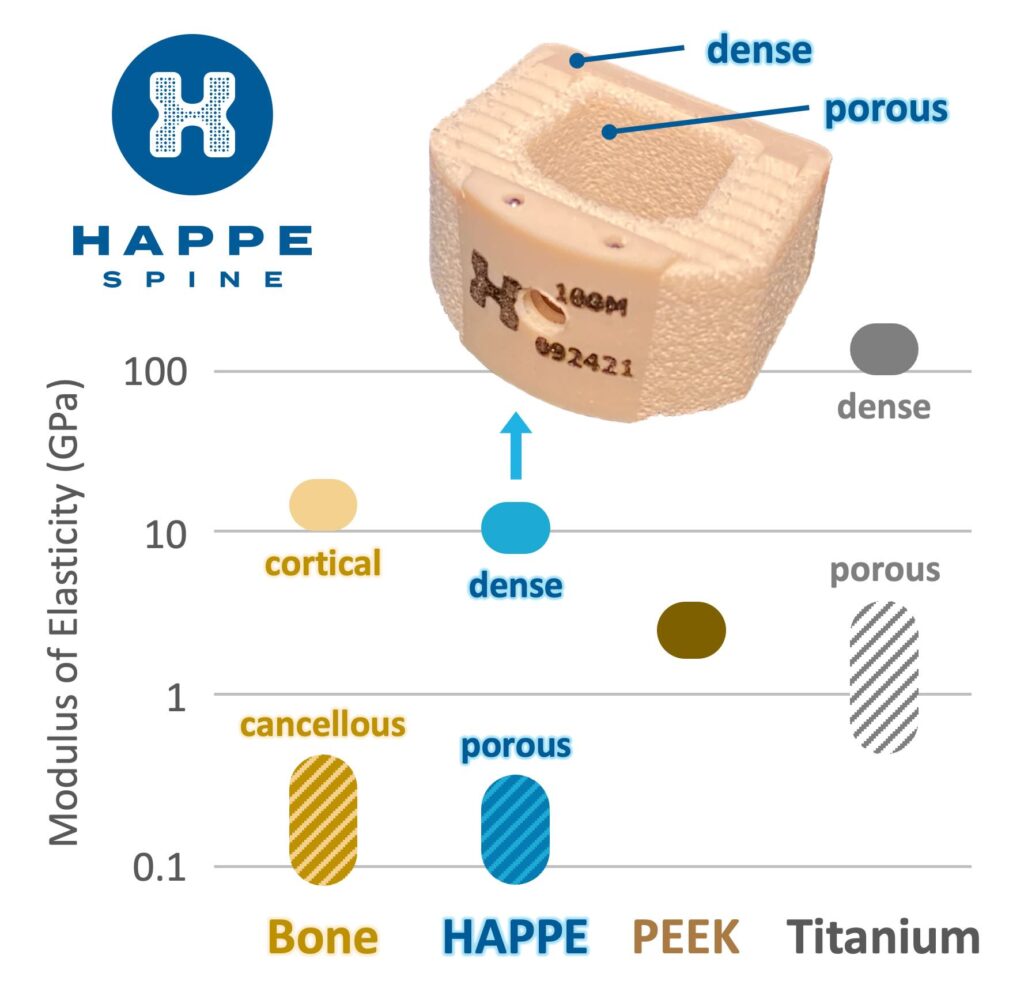
The following contains excerpts from “Backbones of Innovation Signal What’s Next in Spine Care” by Dan Cook at BONEZONE
Achieving “PEEK” Performance
The advancement of new biomaterials is the most significant development in spine surgery, according to Ryan Roeder, Ph.D., Founder and Chief Technology Officer of HAPPE Spine. He pointed to the growing interest in polyetheretherketone (PEEK) devices that incorporate porosity and enhanced tissue integration in spinal implants.
About 20 years ago, Dr. Roeder noted, PEEK implants addressed specific challenges associated with dense titanium devices, which at the time were rigid and didn’t effectively transfer loads to the graft space to promote fusion. The titanium devices were also challenging to image, particularly postoperatively, making it hard to assess fusion success.
“When PEEK implants were first introduced, they facilitated load transfer to the graft space — mechanical loads play a pivotal role in bone formation — and enhanced the osteogenic response,” Dr. Roeder said. “PEEK implants also allowed surgeons to see what was happening within the graft space.”
But traditional PEEK is inert and hydrophobic and can lead to fibrous tissue growth around the implant. “This limitation was manageable until 3D-printed titanium implants with porous structures emerged,” Dr. Roeder noted. “Titanium is known to be osteoconductive — bone can grow along its surface and even into its pore spaces. These factors addressed the previous deficiency of PEEK.”
Dr. Roeder heard the buzz about 3D-printed titanium implants at spine society meetings. “Surgeons were excited about their osteoconductivity, which could result in better stability, improved outcomes and potentially faster fusions,” he recalled. “However, they still struggled with imaging and had concerns about implant rigidity.”
When asked how 3D-printed titanium implants could be improved upon, one surgeon suggested making PEEK implants similarly osteoconductive. Dr. Roeder smiled and told them what HAPPE was working on.
“We’re focused on creating porous and surface-active PEEK devices, which have become a significant area of interest,” he said. “Multiple other companies are also working to bring related products to market.”
Spine has seen multiple transitions in implant materials from dense titanium to dense PEEK to porous titanium, Dr. Roeder noted. “The next logical step is porous PEEK, which combines the advantages of both materials,” he added.
When manufacturing porous PEEK, Dr. Roeder noted, addressing the surface becomes crucial. Some methods, such as coatings or fillers, make the surface of PEEK more hydrophilic and osteoconductive than PEEK alone.
“We incorporate hydroxyapatite into the PEEK material to treat the surface,” Dr. Roeder said. “Other companies may use surface coatings. Our surface modification is a key component of our implant material formula.”

HAPPE Spine’s INTEGRATE-C Interbody Fusion System received FDA clearance in May 2023 and was used for the first time in surgery three months later. The fusion cage is said to be the first of its kind to fully incorporate both porosity and hydroxyapatite throughout the entire structure.
Unlike previous PEEK implants that only had porosity on the end plates, INTEGRATE-C’s porosity extends from plate to plate. “This design allows for the comprehensive integration of the graft window, which is crucial for fusion and biomechanical stability,” Dr. Roeder said. “We want the bone to quickly grow through the window and then seamlessly integrate with the implant.”
INTEGRATE-C’s cage is described as radiolucent and radiovisible, which offers the best of both worlds in terms of imaging performance. “Although we’ve included markers, such as tantalum spheres, to meet FDA requirements, some surgeons have suggested they aren’t necessary because the implant looks like bone right from the start thanks to the significant presence of hydroxyapatite,” Dr. Roeder said.
INTEGRATE-C also addresses the issue of fibrous tissue encapsulation. Surgeons favor the idea of having a PEEK implant that can fully integrate with the surrounding bone during fusion, Dr. Roeder notes. “Our INTEGRATE branding plays off the concept of osseointegration to highlight our unique combination of porosity, hydroxyapatite and imaging capabilities into a single implant.”
